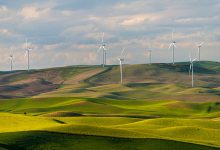The Clean Energy Regulator has declared Australia’s 2020 renewable energy target to be officially met, after the Cattle Hill wind project in Tasmania took the total amount of committed wind, solar and other renewable projects to more than 6,400MW.
That’s the capacity that the CER estimates is required to meet the 2020 target of 33,000GWh of “new” renewables, a number that was originally 45,000GWh before a carving out of rooftop solar took it to 41,000GWh, and then a dramatic reduction under the Abbott government saw the large scale number cut to 33,000GWh.
The CER should probably wait until all that wind and energy capacity is actually on line, and producing the mandated 33,000GWh before declaring the target is met, given the delays in connections and commissioning which is affecting so many projects.
When that 33,000GWh of production is reached, then large scale renewables (including pre-existing hydro) will likely account for 23-24 per cent of Australia’s total demand, and rooftop solar will take that total to around 29 per cent.
The question for many in the industry is what happens next. The CER’s assessment that there is another 6,400MW – the same capacity again – in the pipeline and likely to be constructed over coming years.
Some of that capacity is positioned to take advantage of Victoria’s and Queensland’s commitment to 50 per cent renewables by 2030, targets that cause the Coalition and conservatives to recall in horror and forewarn of disasters ahead.
Some of that new capacity is waiting for opportunities as old coal generators quit the grid in NSW, and others are queuing up in South Australia because it makes such good economic sense, so much so that the state’s Liberal government has an unofficial target of “net 100 per cent renewables” by 2030, but is likely to get there well before then.
“It is now certain Australia will generate enough renewable energy to meet the 2020 Large-scale Renewable Energy Target,” CER chairman David Parker said in a statement.
He noted that the 6,400MW of large scale renewable capacity would be largely built in the three years from 2017 and 2019 – following a three year investment drought brought about by Abbott’s campaign against wind and solar and his efforts to scrap the RET altogether
On 30 August 2019, this milestone was met ahead of schedule with the approval of four large wind and solar power stations, with a combined capacity of 406MW.
The actual project that reached the milestone was the approval of the 148.5MW Cattle Hill Wind Farm, owned by Goldwind and partners, saw the milestone surpassed. That created a neat parenthesis – because it was Goldwind’s 175MW White Rock Wind Farm in NSW that broke the investment drought in 2017 (apart from the ACT wind and solar farms which fall outside the RET)..
“This achievement represents the hard work of a growing and dynamic renewables industry,” said Mr Parker.
“Not only did Goldwind kick off the momentum of renewable energy investments, their Cattle Hill Wind Farm pushed us over the 6400 megawatts of renewable energy capacity.”
Parker said it expects 6410MW of renewable energy to be built over the coming years. “While future investment faces a number of constraints, this is by no means the end of renewable energy investment in Australia, with markets continuing to innovate and adapt to opportunities and challenges.”
The RET is in place until 2030, although it provides no price signal for any further investment, and the price of large scale renewable energy certificates is expected to fall to near zero within a few years, forcing the anti-renewables brigade in conservative media to invent new numbers to demonise the technology.
Energy minister Angus Taylor, who campaigned against the RET before he entered parliament in 2013, and fought to have it repealed after he entered parliament, says the federal government will not extend the RET, or set any new target for renewables.
In an interview with ABC radio on Wednesday, Taylor said wind and particularly solar had fallen dramatically, and did not need new subsidies, and the issue was ensuring enough back-up “when the sun doesn’t shine and the wind doesn’t blow.”
The Clean energy industry says while new subsidies are not needed, it’s hard for investors to make financial commitments without a federal energy policy in place. The RET had shown what could be done with a bipartisan policy (as it was when first legislated in 2012).
“With the news that the industry will far exceed the target, the question should now turn to what comes next,” Clean Energy Council CEO Kane Thornton said in a statement.
“The industry doesn’t need new subsidy, we just need certainty – renewable energy can continue to create opportunities for regional parts of the country for many decades with the right policies in place.”
Thornton said the result showed what is possible when the country’s major political parties agree to put aside their differences and work together to achieve a shared, ambitious goal.
“The RET is the most successful emissions reduction policy of all time for Australia’s electricity system,” Thornton said.
“At a time when people are becoming increasingly concerned about climate change, the RET has been one of the bright spots which is making our electricity system cleaner, cheaper and more reliable.
The policy was a world first when introduced by Prime Minister John Howard in 2001, even though it aimed then to provide only 2 per cent of total generation. RETs, or their equivalents, were then adopted by more than 100 countries. It was expanded under Kevin Rudd in 2009, and finally legislated three years later.
“The policy has delivered dozens of wind and solar farms this decade, along with tens of thousands of jobs for people in regional parts of the country and tens of billions of dollars in project investment which have created many new economic opportunities in the Australian economy.
.










